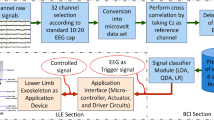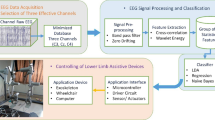Abstract
To control multiple degrees of freedom (MDoF) upper limb prostheses, pattern recognition (PR) of electromyogram (EMG) signals has been successfully applied. This technique requires amputees to provide sufficient EMG signals to decode their limb movement intentions (LMIs). However, amputees with neuromuscular disorder/high level amputation often cannot provide sufficient EMG control signals, and thus the applicability of the EMG-PR technique is limited especially to this category of amputees. As an alternative approach, electroencephalograph (EEG) signals recorded non-invasively from the brain have been utilized to decode the LMIs of humans. However, most of the existing EEG based limb movement decoding methods primarily focus on identifying limited classes of upper limb movements. In addition, investigation on EEG feature extraction methods for the decoding of multiple classes of LMIs has rarely been considered. Therefore, 32 EEG feature extraction methods (including 12 spectral domain descriptors (SDDs) and 20 time domain descriptors (TDDs)) were used to decode multiple classes of motor imagery patterns associated with different upper limb movements based on 64-channel EEG recordings. From the obtained experimental results, the best individual TDD achieved an accuracy of 67.05 ± 3.12% as against 87.03 ± 2.26% for the best SDD. By applying a linear feature combination technique, an optimal set of combined TDDs recorded an average accuracy of 90.68% while that of the SDDs achieved an accuracy of 99.55% which were significantly higher than those of the individual TDD and SDD at p < 0.05. Our findings suggest that optimal feature set combination would yield a relatively high decoding accuracy that may improve the clinical robustness of MDoF neuroprosthesis.
Trial registration: The study was approved by the ethics committee of Institutional Review Board of Shenzhen Institutes of Advanced Technology, and the reference number is SIAT-IRB-150515-H0077.




Similar content being viewed by others
References
Al-Angari, H.M., Kanitz, G., Tarantino, S., and Cipriani, C., Distance and mutual information methods for EMG feature and channel subset selection for classification of hand movements. Biomed Signal Process Control. 27:24–31, 2016.
Samuel, O.W., Zhou, H., Li, X., Wang, H., Zhang, H., Sangaiah, A.K., and Li, G., Pattern recognition of electromyography signals based on novel time domain features for amputees’ limb motion classification. Comput Electr Eng. 2017:1–10, 2017.
Scheme, E., and Englehart, K., Electromyogram pattern recognition for control of powered upper-limb prostheses: State of the art and challenges for clinical use. J Rehabil Res Dev. 48(6):643–660, 2011.
Li, X., Samuel, O.W., Zhang, X., Wang, H., Fang, P., and Li, G., A motion-classification strategy based on sEMG-EEG signal combination for upper-limb amputees. J Neuro Eng Rehab. 14(2):1–13, 2017.
Kuiken, T.A., Li, G., Lock, B.A., Lipschutz, R.D., Miller, L.A., Stubblefield, K.A., and Englehart, K., Targeted muscle reinnervation for real-time myoelectric control of multifunctional artificial arms. JAMA. 301:619–628, 2009.
Huang, H., et al., An analysis of EMG electrode configuration for targeted muscle reinnervation based neural machine interface. IEEE Trans Neural Sys Rehab Eng. 16:37–45, 2008.
Meng, J., Zhang, S., Bekyo, A., Olsoe, J., Baxter, B., and He, B., Noninvasive electroencephalogram based control of a robotic arm for reach and grasp tasks. Sci Rep, 2016. https://doi.org/10.1038/srep38565.
Brunner, C., Naeem, M., Robert, L., Graimann, B., and Pfurtscheller, G., Spatial filtering and selection of optimized components in four class motor imagery EEG data using independent components analysis. Pattern Recogn Lett. 28:957–964, 2007.
Samuel, O. W., Li, X., Geng, Y., Feng, P., Chen, S., and Li, G. Motor imagery classification of upper limb movements based on spectral domain features of EEG patterns. In: Engineering in Medicine and Biology Society (EMBC), 39th Annual International Conference of the IEEE 2017 Jul 11 (pp. 2976–2979). IEEE, 2017.
Samuel, O. W., Li, X., Zhang, X., Wang, H., and Li, G. A hybrid non-invasive method for the classification of amputee’s hand and wrist movements, in IFMBE Proceedings, International Conference on Biomedical Engineering and Health Informatics (ICBHI 2015), 9–10 October, Haikou, China, 2015. http://www.springer.com/gp/book/9789811045042
Yi, W., Qiu, S., Qi, H., Zhang, L., Wan, B., and Ming, D.E.E.G., Feature comparison and classification of simple and compound limb motor imagery. J Neuroeng Rehab. 10(1):106, 2013.
Wang, Y. J., Gao, S. K., and Gao, X. R. Common spatial pattern method for channel selection in motor imagery based brain–computer Interface. In: Proceedings of the 27th international conference of IEEE Engineering in Medicine and Biology Society (pp. 5392–5395). 2005.
Kavitha, P. T., Neethu, R., and Vinod, A. P. EEG-based motor imagery classification using subject-specific Spatio-spectral features. In: 2017 I.E. international conference on systems, man, and cybernetics (SMC) Banff center, Banff, Canada, October 5–8 (pp. 2302–2307). 2017
Gregory, A.L., et al., Electroencephalography (EEG) and event-related potentials (ERP’s) with human participants. Curr Protoc Neurosci, 2010. https://doi.org/10.1002/0471142301.ns0625s52.
Delorme, A., and Makeig, S.E.E.G.L.A.B., An open source toolbox for analysis of single-trial EEG dynamics including independent component analysis. J Neurosci Methods. 134:9–21, 2004.
Liang, W., Tang, M., Jing, L., Sangaiah, A.K., and Huang, Y., SIRSE: A secure identity recognition scheme based on electroencephalogram data with multi-factor feature. Comput Electr Eng, 2017. https://doi.org/10.1016/j.compeleceng.2017.05.001.
Boostani, R., and Moradi, M.H., Evaluation of the forearm EMG signal features for the control of a prosthetic hand. Physiol Meas. 24:309–319, 2003.
Zhang, R., Shen, J., Wei, F., Li, X., and Sangaiah, A.K., Medical image classification based on multi-scale non-negative sparse coding. Artif Intell Med, 2017. https://doi.org/10.1016/j.artmed.2017.05.006.
Oskoei, M. A., and Hu, H. GA-based feature subset selection for myoelectric classification. In: Proceedings of IEEE International Conference on Robotics Biomimetics (pp. 1465–1470). 2006.
Oskoei, M.A., and Hu, H., Support vector machine-based classification scheme for myoelectric control applied to upper limb. IEEE Trans Biomed Eng. 5(8):1956–1965, 2008.
Phinyomark, A., Phukpattaranont, P., and Limsakul, C., Feature reduction and selection for EMG signal classification. Expert Syst Appl. 39(8):7420–7431, 2012.
Qingju, Z., and Zhizeng, L., Wavelet de-noising of electromyography. In: Proceedings of IEEE international conference on mechatronics automation, pp. 1553–1558, 2006.
Biopac Systems Inc. EMG frequency signal analysis. 2010. http://www.biopac.com/Manuals/app_pdf/app118.pdf.
Samuel, O. W., Fang, P., Chen, S., Geng, Y., and Li, G. Activity Recognition Based on Pattern Recognition of Myoelectric Signals for Rehabilitation. In: Handbook of Large-Scale Distributed Computing in Smart Healthcare (pp. 427–442). Cham: Springer, 2017.
Du, S., and Vuskovic, M. Temporal vs. spectral approach to feature extraction from prehensile EMG signals. In: Proceedings of IEEE International Conference on Information Reuse and Integration (pp. 344–350). 2004.
Kim, K.S., Choi, H.H., Moon, C.S., and Mun, C.W., Comparison of k-nearest neighbor, quadratic discriminant and linear discriminant analysis in classification of electromyogram signals based on the wrist-motion directions. Curr Appl Phys. 11(3):740–745, 2011.
Fougner, A. Proportional myoelectric control of a multifunction upper limb prosthesis. Master’s Thesis, Norwegian University of Science and Technology, Trondheim, Norway, 2007.
Boostani, R., and Moradi, M.H., Evaluation of the forearm EMG signal features for the control of a prosthetic hand. Physiol Meas. 24(2):309–319, 2003.
Tkach, D., Huang, H., and Kuiken, T.A., Study of stability of time-domain features for electromyographic pattern recognition. J Neuro Eng Rehab. 7(21):1–13, 2010.
Zardoshti-Kermani, M., Wheeler, B.C., Badie, K., and Hashemi, R.M.E.M.G., Feature evaluation for movement control of upper extremity prostheses. IEEE Trans Rehab Eng. 3(4):324–333, 1995.
Hudgins, B., Parker, P., and Scott, R.A., New strategy for multifunction myoelectric control. IEEE Trans Biomed Eng. 40(1):82–94, 1993.
Sun-Ae, P., et al., Evaluation of feature extraction methods for EEG-based brain–computer interfaces in terms of robustness to slight changes in electrode locations. Med Biol Eng Comput. 51:571–579, 2013.
Philipson, L. The electromyographic signal used for control of upper extremity prostheses and for quantification of motor blockade during epidural anaesthesia. Ph.D. Thesis, Linköping University, Linköping, Sweden, 1987.
Park, S.H., and Lee, S.P.E.M.G., Pattern recognition based on artificial intelligence techniques. IEEE Trans Rehab Eng. 6(4):400–405, 1998.
Saridis, G.N., and Gootee, T.P.E.M.G., Pattern analysis and classification for a prosthetic arm. IEEE Trans Biomed Eng. 29(6):403–412, 1982.
Samuel, O. W., Li, X., Fang, P., and Li, G. Examining the effect of subjects’ mobility on upper-limb motion identification based on EMG-pattern recognition. In: IEEE Asia-Pacific Conference on Intelligent Robot Systems, Tokyo, Japan, Jul. 20–24, (pp. 139–141). 2016.
Samuel, O.W., Geng, Y., Asogbon, M.G., Fang, P., Huang, Z., and Li, G., Resolving the adverse impact of mobility on myoelectric pattern recognition in upper-limb multifunctional prostheses. Comput Biol Med. 90(2017):76–87, 2017.
Samuel, O.W., Asogbon, M.G., Sangaiah, A.K., Fang, P., and Li, G., An integrated decision support system based on ANN and Fuzzy_AHP for heart failure risk prediction. Expert Syst Appl. 68:163–172, 2016.
Lucas, M.F., Gaufriau, A., Pascual, S., Doncarli, C., and Farina, D., Multi-channel surface EMG classification u sing support vector machines and signal-based wavelet optimization. Biomed Signal Process Control. 3(2):169–174, 2008.
Siuly, Y. L., Jinglong, W., and Jingjing, Y. Developing a logistic regression model with cross-correlation for motor imagery signal recognition. In: Proceedings of the 2011 IEEE/ICME international conference on complex medical engineering (CME), Harbin, China (pp. 502–507). 2011.
Siuly, S., and Li, Y., Improving the separability of motor imagery EEG signals using a cross correlation-based least square support vector machine for brain–computer interface. IEEE Trans Neural Sys Rehab Eng. 20:526–538, 2012.
Khorshidtalab, A., Salami, M.J.E., and Hamedi, M., Robust classification of motor imagery EEG signals using statistical time-domain features. Physiol Meas. 34(2013):1563–1579, 2013.
Pistohl, T., et al., Prediction of arm movement trajectories from ECoG-recordings in humans. J Neurosci Methods. 167:105–114, 2008.
Englehart, K., and Hudgins, B., A robust, real-time control scheme for multifunction myoelectric control. IEEE Trans Biomed Eng. 50:848–854, 2003. https://doi.org/10.1109/TBME.2003.813539.
Li, X., Chen, S., Zhang, H., Samuel, O.W., Wang, H., Fang, P., Zhang, X., and Li, G., Towards reducing the impacts of unwanted movements on identification of motion intentions. J Electromyogr Kinesiol. 28:90–98, 2016. https://doi.org/10.1016/j.jelekin.2016.03.005.
Phinyomark, A., et al., EMG feature evaluation for improving myoelectric pattern recognition robustness. Expert Syst Appl. 40(2013):4832–4840, 2013.
Funding
The Research work was supported in part by the National Natural Science Foundation of China under Grants (#91420301, #61403367), the National High-Tech. Research and Development Program of China under Grant (#2015AA042303), the Natural Science Foundation of Guangdong Province under Grant (#2016A030313179), the Shenzhen Governmental Basic Research Grant (#JCYJ20160331185848286, #JCYJ20150401145529005), and the Shenzhen High-level Oversea Talent Program (Shenzhen Peacock Plan) Grant (#KQCX2015033117354152), and the Outstanding Youth Innovation Research Fund of Shenzhen Institutes of Advanced Technology, Chinese Academy of Sciences (#Y7G016). Lastly, I (Oluwarotimi Williams Samuel) sincerely appreciate the support of CAS-TWAS President’s Fellowship to pursue a Ph.D. degree at the University of Chinese Academy of Sciences, Beijing, China.
Author information
Authors and Affiliations
Corresponding author
Ethics declarations
Conflict of Interest
The authors declare that they have no conflict of interest.
Additional information
This article is part of the Topical Collection on Image & Signal Processing
Rights and permissions
About this article
Cite this article
Samuel, O.W., Geng, Y., Li, X. et al. Towards Efficient Decoding of Multiple Classes of Motor Imagery Limb Movements Based on EEG Spectral and Time Domain Descriptors. J Med Syst 41, 194 (2017). https://doi.org/10.1007/s10916-017-0843-z
Received:
Accepted:
Published:
DOI: https://doi.org/10.1007/s10916-017-0843-z




